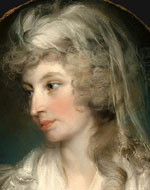
This exhibition is no longer on view at the National Gallery. Please follow the links below for related online resources or visit our current exhibitions schedule.
 Pastels were first made and used in the 16th century, but their
full potential for producing full-color, finished drawings was
first realized only in the 18th century. In the past decade the
National Gallery of Art has acquired outstanding pastels by some
of the foremost 18th-century masters of pastel.
Pastels were first made and used in the 16th century, but their
full potential for producing full-color, finished drawings was
first realized only in the 18th century. In the past decade the
National Gallery of Art has acquired outstanding pastels by some
of the foremost 18th-century masters of pastel.
The centerpiece of the exhibition is a masterwork by the Swiss artist, Jean-Étienne Liotard, universally considered one of the greatest pastellists of all time. In his rendering of An Elegant Young Woman in Maltese Costume (c. 1745), Liotard combines a monumental formal composition with subtle handling of color, light, and texture. Among the other exceptional works on view will be a sketch by Jean-Baptiste Greuze of his wife, a famous beauty, made in preparation for the central figure in Greuze's painting of The Well-Loved Mother (1765). In that same year, the young American John Singleton Copley executed his portrait of John Temple (1765), one of the finest and most confident examples of Copley's early skill in pastel. In England, John Russell was known as "the prince of pastellists," and two of his renderings of women, one made in 1783, the other in 1794, represent the classic British taste in pastel portraiture. The exhibition will be rounded out by two contrasting works by French artists: a rendering by Claude Bornet (1767) of an elderly lady wearing an elaborately beribboned silk dress; and a portrait by Adélaïde Labille-Guiard of a young noblewoman in a plumed hat (1787).
These seven works are just a small sampling of the National Gallery of Art's collection of drawings executed in colored chalks and pastels from the 16th century to the present day. Though limited to some of the newest acquisitions of pastels from a single century, the selection bears witness to the newfound depth and breadth of the National Gallery's pastel collection as a whole.


